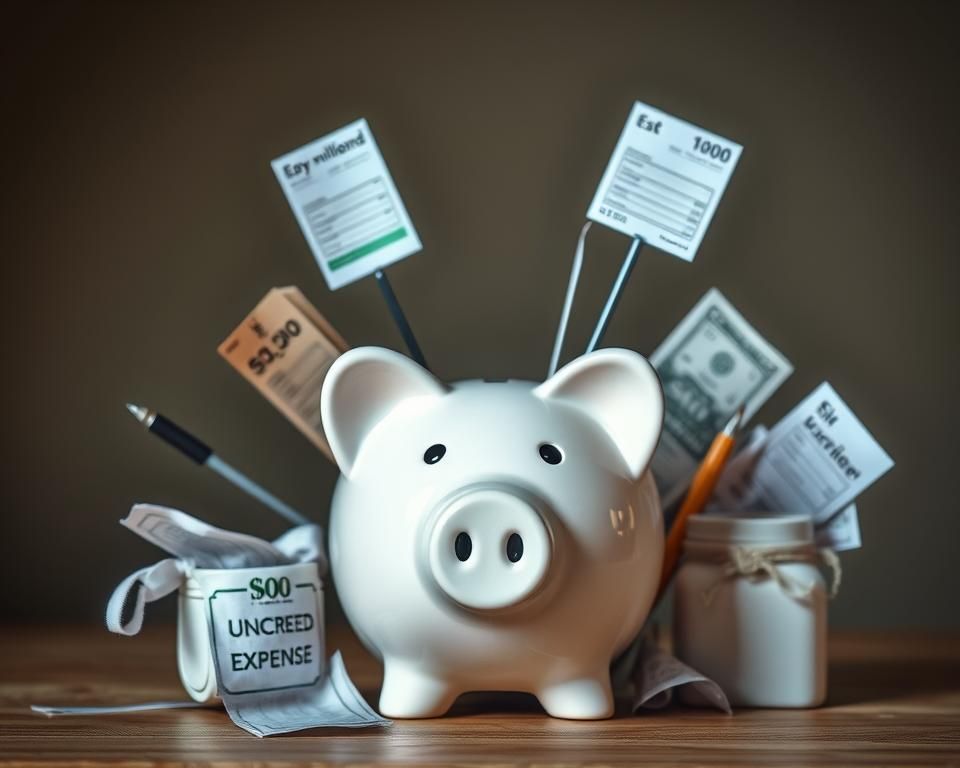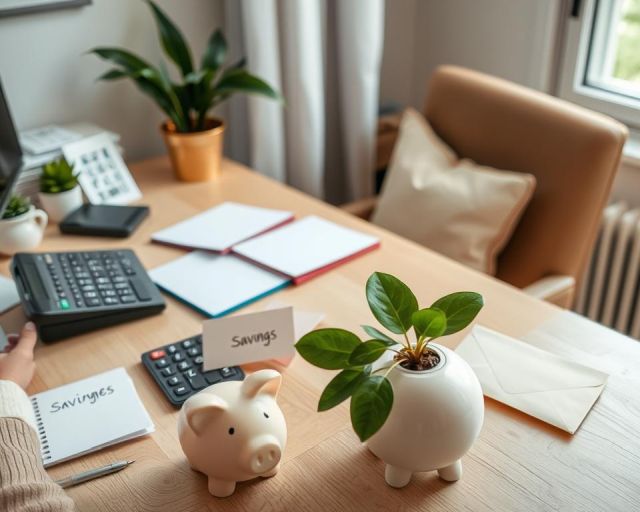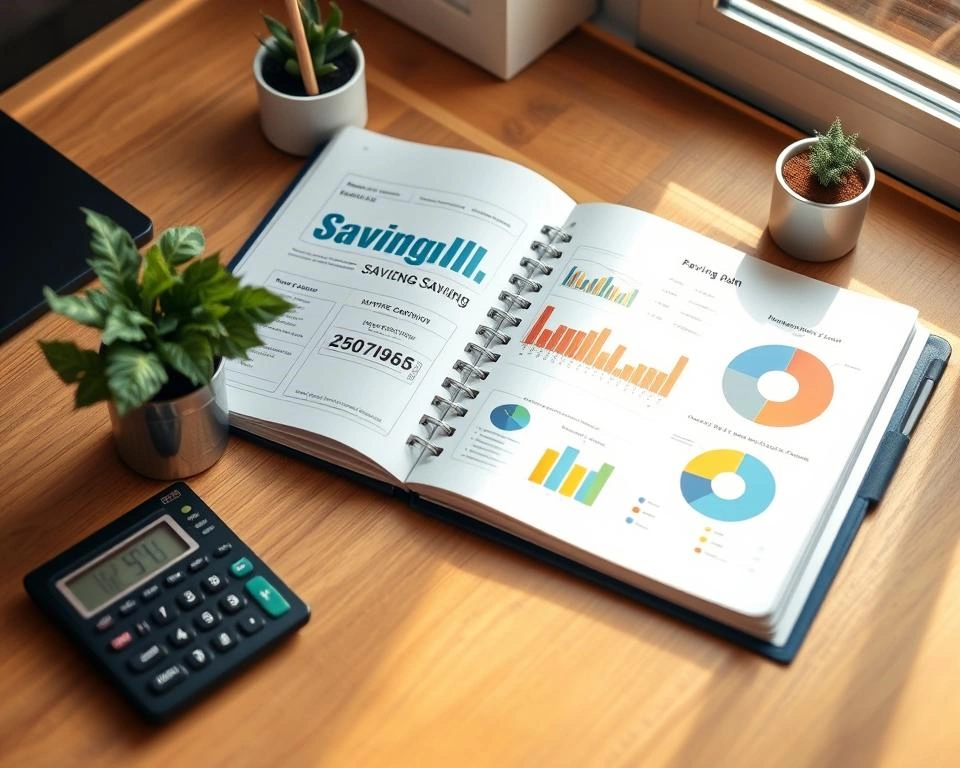Did you know 56% of Americans have less than three months of living expenses saved? And 27% have no savings at all. An emergency fund is key to keeping your finances safe. It helps when unexpected things happen, like job loss or medical emergencies.
Experts say you should save 3 to 6 months of living expenses. This can change based on your lifestyle and income. Saving this much helps cover important costs like rent and food during tough times.
Understanding the Importance of an Emergency Fund
An emergency fund is like a financial safety net. It helps you deal with unexpected costs or financial crises. It’s not for long-term savings but a key tool to avoid debt or touching your retirement savings when things get tough.
What Is an Emergency Fund?
An emergency fund is a special savings account for urgent, unplanned expenses. These can be medical bills, car repairs, job loss, or other emergencies. Its main goal is to keep your finances stable and give you peace of mind so you can handle unexpected costs without harming your financial health.
Having an emergency fund has many benefits:
- Avoids Debt: Using your emergency savings instead of credit cards or loans saves you from interest charges and credit damage.
- Protects Long-Term Savings: It keeps your retirement, education, or other long-term savings safe for their intended use.
- Reduces Financial Stress: Having a financial cushion reduces stress from unexpected expenses.
- Supports Financial Flexibility: With an emergency fund, you can handle life’s surprises better without making incorrect financial choices.
In short, an emergency fund is vital for a solid financial plan. It ensures your long-term financial stability and well-being.

“An emergency fund is the foundation of a strong financial plan. It provides a safety net that can protect you from the unexpected and help you maintain your financial footing during difficult times.”
Determining the Appropriate Emergency Fund Size
Figuring out the right size for your emergency fund depends on your personal situation. Experts say to save 3-6 months’ worth of living expenses. This helps you deal with sudden costs like medical bills or car repairs without financial stress.
But the amount you should save can change based on your monthly expenses, job stability, and family size. If you have a steady job and fewer dependents, you might need less. But if your income is unpredictable or you have more financial responsibilities, you might need to save more.
Start building your emergency fund slowly. Set achievable savings goals and add to it regularly. This way, you’ll have enough money saved for your specific needs. It helps protect you from unexpected costs.
“The size of your emergency fund should be based on your unique financial situation, but a general guideline is to have 3-6 months’ worth of living expenses saved up.”

The recommended emergency fund amount varies for everyone. Your personal finances and goals should help decide how much to save. By carefully planning and saving, you can build a strong financial safety net for any surprises.
Where to Keep Your Emergency Fund
When deciding where to store your emergency fund, look for a spot that’s simple to get to, safe, and might earn a little interest. Savings accounts, money market accounts, or cash management accounts are excellent choices. They let you get your money fast without losing any or facing penalties.
Don’t put your emergency fund in stocks, bonds, or other risky investments. These might grow your money, but they can also lose it. An emergency fund is for quick, safe money, not for making a lot of money.
- Savings accounts: These accounts let you get your money right away and earn a little interest. They’re a safe spot for your emergency savings.
- Money market accounts: They might earn a bit more interest than regular savings accounts. But they’re still very safe and simple to get to.
- Cash management accounts: They mix the features of checking and savings accounts. They offer quick access to your money and a favorable interest rate.
The best emergency fund accounts are those that are simple to get to, safe, and might earn a little interest. By choosing the right account, your emergency fund will be ready when you need it. And it won’t be at risk of losing money.

“The key is finding the right balance between accessibility, safety, and potential returns on your emergency savings.”
When to Use Your Emergency Fund
Your emergency fund is for real emergencies, not for fun spending. It’s meant to help you through tough times like job loss or sudden illness. Always try to save it back as soon as you can.
Common Emergencies Requiring an Emergency Fund
Here are some times you might need your emergency fund:
- Losing your job or getting a big pay cut
- Unexpected medical bills from a sudden illness or injury
- Big home repairs, like a leaky roof or a broken furnace
- Expensive car repairs or needing a new one
- Damage to your home from a natural disaster, like a tornado or flood
Remember, your emergency fund is for real, urgent needs. Don’t use it for things you can delay or skip.

“An emergency fund is like a financial parachute—it’s there to catch you if you fall, but you shouldn’t be jumping out of planes just for the thrill of it.” – Rachel Cruze, personal finance expert
By using your emergency fund wisely and saving it back, you’ll have it ready for when you really need it.
How Much to Save for Emergency Fund
Experts say you should save 3 to 6 months’ worth of living costs for an emergency fund. This helps cover unexpected bills and lost income without using credit cards or loans. First, figure out your monthly must-haves like rent, utilities, and food. Then, multiply this by 3 to 6 to find your emergency fund goal.
Your emergency fund size depends on your living costs, not your salary. Aim for at least three months’ worth of rent, bills, debts, and food. This helps you handle small to medium emergencies, like car repairs or short-term job losses.
If you face a lot of unexpected costs or have shaky income, save more than six months’ worth. But if you’re financially stable and less worried about risks, you might get by with just three months’ savings.
“Most people should aim to maintain three to six months of total expenses in their emergency savings.”
To build your emergency fund, set up automatic transfers from your checking to a savings account. This makes saving easier and less likely to be forgotten.

Finding the right emergency fund size is all about your financial situation and risks. Talking to a financial advisor can help you figure out how much to save. They can also help you balance your financial goals, including saving for emergencies.
Building Your Emergency Fund Step by Step
Creating an emergency fund is key to securing your financial future. It might seem hard, but breaking it down into steps makes it easier. The main thing is to set goals and stick to a savings plan.
Setting Realistic Savings Goals
First, figure out how much you need for your emergency fund. Experts say to save three to six months’ worth of living costs. Then, set smaller goals to make it easier.
For example, start by saving for one month’s expenses. Then, work towards the bigger goal. The goal is to save a little bit regularly, not all at once. Set up automatic transfers to your emergency fund to help you save without spending it.

As you save, don’t spend more or get new credit cards. Staying disciplined is important to keep your savings on track.
When you reach your goal, use extra savings to invest. This could be in retirement accounts. Balancing emergency savings with investments helps you plan for both now and later.
Strategies for Replenishing Your Emergency Fund
If you’ve used your emergency fund, start filling it back up right away. It’s key to rebuild your savings until you reach your goal. Here are some beneficial ways to refill your emergency fund:
- Reduce discretionary spending: Look at your budget and find places to cut back. This could be on dining out, entertainment, or subscriptions. Use that money to fill up your emergency fund.
- Increase your income: Think about getting a side job or doing freelance work. This can help you earn more and put that money towards your emergency fund.
- Automate your savings: Set up automatic transfers from your checking account. Or, put a part of your paycheck into your emergency fund. This makes saving simple and automatic.
- Review and adjust your savings rate: Check your emergency fund balance often. Change how much you save if needed. Try to save enough for three to six months of expenses. Or up to eight months if you have only one income or rely on family.
Remember, rebuilding your emergency fund after using it is crucial to protecting your financial well-being. By using these strategies, you can replenish your emergency savings and refill your emergency fund with confidence.

“Having an emergency fund is like a financial insurance policy—it can save you from going into debt or dipping into long-term savings when unexpected expenses arise.”
Investing Your Emergency Fund for Growth
While your emergency fund is for quick cash needs, you can invest some to earn more. You might put some in a high-yield savings account, money market fund, or short-term bond fund. But keep most of it in safe, easy-to-access accounts.
It’s about finding a balance. You want your emergency savings to be simple to get, safe, and grow a bit. Experts say keep three to six months’ expenses in liquid assets. This amount depends on your life and money needs.
Thinking about investing your emergency fund? Having a big emergency fund, excellent credit, and stable income helps. Also, having health insurance and an HSA is good. Saving extra for market drops is smart to keep funds safe.
Choosing where to put your emergency fund is key. You might pick a taxable brokerage account or a Roth IRA. Each has its own tax rules. Start with a safe mix and slowly add more risk as your fund grows. Spread your investments to reduce risk and keep your fund stable.

“Investing your emergency fund may not be suitable if you have high-interest debt, an unstable job, or are just starting an emergency fund.”
By smartly managing your emergency fund investments, you can earn interest on emergency savings and grow your emergency fund. This way, you keep your fund safe and ready for when you need it.
Building an emergency fund is key to a solid financial plan. Save 3-6 months’ living costs in an easy-to-reach account. This helps you face unexpected costs without debt.
An emergency fund lowers stress and boosts saving habits. It stops you from using high-interest debt in crises. Saving this amount takes time and discipline, but it’s worth it for peace of mind.
With a sufficient emergency fund, you can reach your long-term goals without worry. Follow the advice in this article to build a strong emergency fund. It will be your reliable safety net for the future.

Tips on Building an Emergency Fund: How Much Should You Save?
- Aim for 3-6 Months of Expenses
Financial experts recommend saving 3-6 months’ worth of essential expenses, depending on your job stability and financial situation. - Start Small, Think Big
Begin with a smaller goal, such as $500 or $1,000, to create momentum and build confidence. - Track Your Monthly Expenses
Calculate your fixed expenses (e.g., rent, utilities, food) to determine the exact amount needed for an emergency fund. - Prioritize High-Interest Debt
While saving, also focus on paying down high-interest debts like credit cards to reduce financial strain. - Automate Your Savings
Set up automatic transfers from your checking account to a dedicated savings account to make saving consistent and effortless. - Separate Your Emergency Fund
Use a high-yield savings account or money market account to keep your fund accessible but not too tempting to spend. - Create a Budget for Savings
Incorporate a specific savings goal into your monthly budget to ensure consistent progress. - Avoid Investing Your Emergency Fund
Emergency funds should be liquid and accessible, not tied up in volatile investments. - Adjust for Inflation and Life Changes
Review and adjust your emergency fund annually to reflect changes in living costs, family size, or income. - Start with a Percentage of Your Income
Begin by saving 10%–20% of your income until you reach your desired emergency fund amount. - Use Windfalls Strategically
Allocate tax refunds, bonuses, or unexpected income directly to your emergency fund. - Cut Unnecessary Expenses
Identify and reduce discretionary spending to redirect those funds into your savings. - Include Irregular Expenses
Account for non-monthly expenses like car repairs or medical bills in your emergency fund goal. - Track Your Progress
Monitor your savings growth to stay motivated and make adjustments as needed. - Use Visual Goals
Create a chart or tracker to visualize your progress toward your emergency fund target. - Don’t Stop After Reaching Your Goal
Continue saving beyond your initial goal to create a financial cushion for larger emergencies. - Prepare for Job Loss
If your industry or role is volatile, aim for 6–12 months’ worth of expenses for added security. - Avoid Tapping Into It Prematurely
Reserve your emergency fund strictly for unforeseen, essential expenses like medical emergencies or urgent home repairs. - Build it Alongside Retirement Savings
While focusing on emergencies, don’t neglect contributions to retirement accounts. - Match Your Savings to Risk Levels
If your income is commission-based or irregular, consider a larger emergency fund. - Learn to Say “No” to Impulse Spending
Strengthen your discipline by prioritizing savings over non-essential purchases. - Plan for Pet Emergencies
If you have pets, include potential vet expenses in your emergency fund calculations. - Account for Medical Insurance Gaps
Include deductibles, co-pays, or out-of-pocket maximums in your emergency savings. - Save for Both Partners in Dual-Income Homes
Dual-income families should still aim for at least 3 months of combined expenses. - Reassess After Major Life Events
Adjust your fund after events like marriage, having a child, or buying a home. - Consider Side Hustles to Boost Savings
Use extra income from side jobs to accelerate your emergency fund growth. - Be Realistic About Your Needs
Customize your emergency fund based on your lifestyle, obligations, and spending habits. - Seek Financial Advice If Needed
Work with a financial advisor to set realistic goals and strategies for building your fund. - Use a Tiered Savings Strategy
Save smaller amounts in cash for immediate needs and larger sums in accessible accounts. - Celebrate Milestones
Reward yourself for reaching savings milestones to stay motivated and positive about the process.
By implementing these tips, you can create a robust emergency fund to protect your financial well-being in times of uncertainty.
Key Takeaways
- An emergency fund should consist of 3 to 6 months of living expenses.
- Start saving small amounts each month to build your emergency fund.
- Focus on saving for 3 months of essential expenses, not your current lifestyle.
- Use an FDIC-insured savings account to keep your emergency funds accessible.
- Only use your emergency fund for unexpected events, not everyday expenses.

Resources:
- Investopedia: “How to Build an Emergency Fund”
This article provides strategies for saving three to six months’ worth of expenses and tips on where to keep your emergency savings. Investopedia - Forbes Advisor: “How To Create An Emergency Fund”
Offers guidance on determining the appropriate amount for an emergency fund and methods to build it effectively. Forbes - Fidelity: “How much emergency fund should you have and where should you keep it”
Discusses the importance of an emergency fund and provides insights on how much to save based on individual circumstances. Fidelity - The Wall Street Journal: “How to Build an Emergency Fund”
Offers a step-by-step guide to establishing an emergency fund, including tips on where to keep the funds for easy access. The Wall Street Journal - Bank of America: “Emergency Fund Tips: How to Start Building a Reserve of Cash”
Provides practical steps to begin saving for an emergency fund, even on a tight budget. Better Money Habits - Kiplinger: “Need to Build an Emergency Fund? Seven Steps to Get There”
Outlines actionable steps to create an emergency fund tailored to your financial situation. Kiplinger - Consumer Financial Protection Bureau: “An essential guide to building an emergency fund”
Explains the significance of an emergency fund and offers strategies to build one effectively. Consumer Financial Protection Bureau - Ramsey Solutions: “Emergency Fund: Why You Need One and How Much to Save”
Provides insights into the purpose of an emergency fund and guidelines on how much to save based on personal circumstances. Ramsey Solutions - The Motley Fool: “Best Places to Keep Your Emergency Fund”
Discusses various account options for storing your emergency fund, highlighting their pros and cons. Fool.com - Investopedia: “Maximize Retirement Savings With These Strategies Even While Living Paycheck to Paycheck”
Offers strategies to save for retirement and emergencies simultaneously, even on a limited budget. Investopedia - Investopedia: “Top 7 Finance Tips for New Grads”
Provides financial advice for new graduates, including the importance of building an emergency fund. Investopedia - Investopedia: “10 Traditional IRA Mistakes You Didn’t Know You Were Making”
Highlights common mistakes in retirement planning, emphasizing the need for an emergency fund to avoid early withdrawals. Investopedia - Investopedia: “Why Upper-Middle Earners Are Living Paycheck to Paycheck”
Discusses the financial challenges faced by higher earners and the importance of having an emergency fund. Investopedia - WCJB: “Expert advice to build an emergency fund”
Offers expert tips on starting and maintaining an emergency fund. WCJB - Investopedia: “3 Ways Experts Say You Can Stash Cash If You’re Worried About Your Job”
Provides strategies to quickly build an emergency fund in anticipation of potential job loss. Investopedia



